Allylic - Study guides, Class notes & Summaries
Looking for the best study guides, study notes and summaries about Allylic? On this page you'll find 42 study documents about Allylic.
Page 2 out of 42 results
Sort by
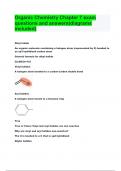
-
Organic Chemistry Chapter 7 exam questions and answers(diagrams included).
- Exam (elaborations) • 14 pages • 2024
-
- $14.99
- + learn more
General formula for alkyl halide C(n)H(2n+1)X Vinyl halides A halogen atom bonded to a carbon-carbon double bond Aryl halides A halogen atom boned to a benzene ring True True or False: Vinyl and aryl halides are non reactive Why are vinyl and aryl halides non-reactive? The X is bonded to a C that is sp2 hybridized Allylic halides Have X bonded to the carbon atom adjacent to a C-C double bond benzylic halides Have X bonded to the carbon atom adjacent to a benz...
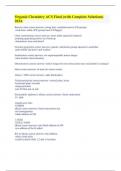
-
Organic Chemistry ACS Final (with Complete Solutions) 2024.
- Exam (elaborations) • 5 pages • 2023
- Available in package deal
-
- $10.99
- + learn more
Basicity rules correct answers -strong base: unstable/reactive (ED groups) -weak base: stable (EW groups/more EN/bigger) Chair conformation correct answers -more stable equitorial (slanted) -pointing up/pointing down=cis if both up -elimination: trans and diaxial Newman projection correct answers -gauche: substituent groups adjacent to eachother -grab middle and turn to put in plane Enantiomers correct answers -not superimposable mirror images -same besides stereochemistry Diast...
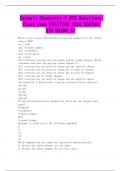
-
Organic Chemistry 1 ACS Questions Final Exam SOLUTION 2024 EDITON AID GRADE A+
- Exam (elaborations) • 11 pages • 2024
-
- $10.99
- + learn more
Which is the correct hybridization state and geometry for the carbon atom in HCN? sp, linear sp2, trigonal planar sp3, tetrahedral None of the above sp, linear The following structure has been drawn without formal charges. Which statement describes the missing formal charge(s)? This structure has one positive charge and one negative charge. This structure has one positive charge but no negative charges. This structure has one negative charge but no positive charges. This structure has ...
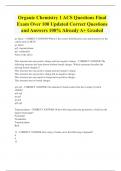
-
Organic Chemistry 1 ACS Questions Final Exam Over 100 Updated Correct Questions and Answers 100% Already A+ Graded
- Exam (elaborations) • 40 pages • 2024
-
- $10.99
- + learn more
Organic Chemistry 1 ACS Questions Final Exam Over 100 Updated Correct Questions and Answers 100% Already A+ Graded sp, linear - CORRECT ANSWER-Which is the correct hybridization state and geometry for the carbon atom in HCN? sp, linear sp2, trigonal planar sp3, tetrahedral None of the above This structure has one positive charge and one negative charge. - CORRECT ANSWER-The following structure has been drawn without formal charges. Which statement describes the missing formal charge(s)...
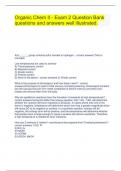
-
Organic Chem II - Exam 2 Question Bank questions and answers well illustrated.
- Exam (elaborations) • 16 pages • 2023
-
- $12.49
- + learn more
Organic Chem II - Exam 2 Question Bank questions and answers well illustrated. A(n) ______ group contains sulfur bonded to hydrogen. - correct answers.Thiol or mercapto Low temperatures are used to achieve- A) Thermodynamic control B) Reactant control C) Kinetic control D) Product control E) None of the above - correct answers.C) Kinetic control What is the purpose of dimercaprol, and how does it work? - correct answers.Dimercaprol is used to treat mercury and lea...
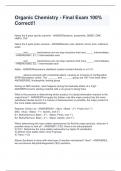
-
Organic Chemistry - Final Exam 100% Correct!!
- Exam (elaborations) • 6 pages • 2024
- Available in package deal
-
- $15.49
- + learn more
Name the 6 polar aprotic solvents - ANSWERacetone, acetonitrile, DMSO, DMF, HMPA, THF Name the 5 polar protic solvents - ANSWERacetic acid, ethanol, formic acid, methanol, water ______ and ______ mechanisms are two step reactions that have _____ intermediates. - ANSWERSN1; E1; 2 Intermediates each ______ and ______ mechanisms are one step reactions that have _____ intermediates. - ANSWERSN2; E2; 1 Intermediate each Allylic - ANSWERresonance stabilized (carbon bonded directly to a C=C...
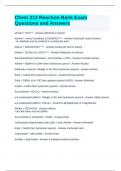
-
Chem 212 Reaction Bank Exam Questions and Answers
- Exam (elaborations) • 3 pages • 2024
- Available in package deal
-
- $9.49
- + learn more
alcohol + PCC*** - Answer-aldehyde or ketone Alcohol + Jones Conditions (CrO3/H3O+)*** - Answer-Carboxylic acid or ketone - an aldehyde can be oxidized to a carboxylic acid Alkene + KMnO4/H3O+ *** - Answer-Carboxylic acid or ketone Alkene + O3 then Zn, HOAc**** - Answer-Aldehydes or ketones Benzene/benzene derivative + acid chloride + AlCl3 - Answer-Aromatic ketone Ald/ket + NaBH4 or LiAlH4 then hydronium quench - Answer-Alcohol Aldehyde or ketone +RMgBr or RLi then hydronium ...
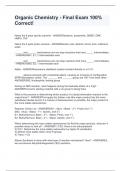
-
Organic Chemistry - Final Exam 100% Correct!
- Exam (elaborations) • 6 pages • 2024
- Available in package deal
-
- $15.99
- + learn more
Name the 6 polar aprotic solvents - ANSWERacetone, acetonitrile, DMSO, DMF, HMPA, THF Name the 5 polar protic solvents - ANSWERacetic acid, ethanol, formic acid, methanol, water ______ and ______ mechanisms are two step reactions that have _____ intermediates. - ANSWERSN1; E1; 2 Intermediates each ______ and ______ mechanisms are one step reactions that have _____ intermediates. - ANSWERSN2; E2; 1 Intermediate each Allylic - ANSWERresonance stabilized (carbon bonded directly to a C=C...
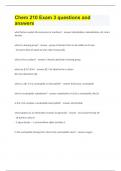
-
Chem 210 Exam 3 questions and answers
- Exam (elaborations) • 11 pages • 2023
- Available in package deal
-
- $14.99
- + learn more
what factors explain the outcomes of reactions? hybridization, delocalization, eN, atom density what is a leaving group? - group of atom(s) that can be stable on its own - eN atoms that are good LG also make strong acids what is the α carbon? C directly attached to leaving group what are β Cs? β Hs? βC: C(s) attached to α carbon βH: H(s) attached to βC what is a LB? is it a nucleophile or electrophile? lewis base, nucleophile what is nucleophilic ...
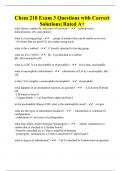
-
Chem 210 Exam 3 Questions with Correct Solutions| Rated A+
- Exam (elaborations) • 9 pages • 2023
- Available in package deal
-
- $10.99
- + learn more
what factors explain the outcomes of reactions? - hybridization, delocalization, eN, atom density what is a leaving group? - - group of atom(s) that can be stable on its own - eN atoms that are good LG also make strong acids what is the α carbon? - C directly attached to leaving group what are β Cs? β Hs? - βC: C(s) attached to α carbon βH: H(s) attached to βC what is a LB? is it a nucleophile or electrophile? - lewis base, nucleophile what is nucleophilic ...

Do you wonder why so many students wear nice clothes, have money to spare and enjoy tons of free time? Well, they sell on Stuvia! Imagine your study notes being downloaded a dozen times for $15 each. Every. Single. Day. Discover all about earning on Stuvia


